You could generate all possible combinations for year, month and product in your data using CROSS JOIN. A simple LEFT JOIN will give you the value or NULL if data for a specific combination exists.
DECLARE @t TABLE (year int, month int, product int, unit int);
INSERT INTO @t VALUES
(2017, 1, 1, 1721),
(2017, 2, 1, 4915),
(2017, 5, 1, 5230),
(2018, 2, 1, 5216),
(2018, 3, 1, 8911),
(2017, 4, 2, 2933),
(2018, 1, 2, 7672);
SELECT ally.year, allm.month, allp.product, curr.units, prev.units AS units_prev
FROM (SELECT DISTINCT year FROM @t) AS ally
CROSS JOIN (SELECT DISTINCT product FROM @t) AS allp
CROSS JOIN (SELECT DISTINCT month FROM @t) AS allm
LEFT JOIN @t AS curr ON curr.year = ally.year AND curr.product = allp.product AND curr.month = allm.month
LEFT JOIN @t AS prev ON prev.year = ally.year - 1 AND prev.product = allp.product AND prev.month = allm.month
Result:
| year | month | product | units | units_prev |
|------|-------|---------|-------|------------|
| 2017 | 1 | 1 | 1721 | NULL |
| 2017 | 2 | 1 | 4915 | NULL |
| 2017 | 3 | 1 | NULL | NULL |
| 2017 | 4 | 1 | NULL | NULL |
| 2017 | 5 | 1 | 5230 | NULL |
| 2017 | 1 | 2 | NULL | NULL |
| 2017 | 2 | 2 | NULL | NULL |
| 2017 | 3 | 2 | NULL | NULL |
| 2017 | 4 | 2 | 2933 | NULL |
| 2017 | 5 | 2 | NULL | NULL |
| 2018 | 1 | 1 | NULL | 1721 |
| 2018 | 2 | 1 | 5216 | 4915 |
| 2018 | 3 | 1 | 8911 | NULL |
| 2018 | 4 | 1 | NULL | NULL |
| 2018 | 5 | 1 | NULL | 5230 |
| 2018 | 1 | 2 | 7672 | NULL |
| 2018 | 2 | 2 | NULL | NULL |
| 2018 | 3 | 2 | NULL | NULL |
| 2018 | 4 | 2 | NULL | 2933 |
| 2018 | 5 | 2 | NULL | NULL |
